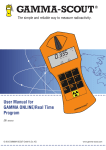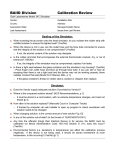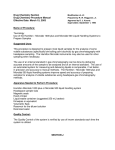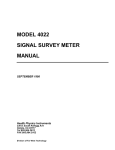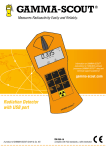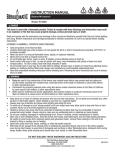Download EHS-502F2 EHS Clearance Decontamination Certification
Transcript
EHS-502F2 EHS Clearance Decontamination Certification Examples of Instrument Decontamination Procedures Please note that the return of instruments or parts that may be contaminated with viable biological agents, harmful quantities of hazardous chemicals, or radioactive materials is subject to Molecular Devices EHS approval. The customer must be willing to provide evidence of below background decontamination results of key areas on the instrument. 1. Biological Agents The following procedures are based on widely used industry standards for instrument or part (hereinafter referred to as instrument) decontamination, but the Customer must assess the suitability of these methods for the biological agents concerned. Some instruments may require decontamination by an outside service. Refer to your User Manual or Molecular Devices Representative for further information. Hazard Group 1 or 2 Instruments exposed to biological agents in Hazard Group 1 or 2, situated in a Biosafety Level/ Containment Level 1 or 2 laboratory, or exposed to any human source material or cell culture including clinical samples: a) Follow Universal Precautions and wear all applicable personal protective equipment. Place the instrument in a wellventilated area. b) Apply a freshly made solution of 1:10 v/v dilution of 5.25% sodium hypochlorite (e.g. Clorox bleach) with water to accessible product surfaces. A spray dispenser may help to ensure complete coverage. c) Keep surfaces wet for at least 15 minutes, then wipe dry. d) Repeat steps (b) and (c). e) Clean all decontaminated surfaces with water to remove residual bleach, and wipe dry. If an alternative to 1:10 v/v dilution of bleach is used for instrument decontamination, please provide details in written form and attached to the Clearance Decontamination Certification. Hazard Group 3 or 4 Instruments situated in Biosafety Level/ Containment Level 3 or 4 laboratories must be decontaminated, by the customer, using an internationally approved sterilization procedure. The customer must then move the instrument to either a Containment Level 1 or 2 laboratory for service. Molecular Devices associates are not permitted to enter Biosafety Level/Containment Level 3 or 4 laboratories. It may not be possible for Molecular Devices to service or transport these instruments. 2. Radioactive Materials Apply an industry standard radioactivity decontaminant (e.g. Radiacwash®, Rad-Con® or equivalent) to the instrument, and wipe surfaces as directed by the decontaminant manufacturer. Survey the instrument with an appropriate radioactivity measuring instrument (e.g. Geiger Counter or scintillation counter). Satisfactory decontamination is defined as survey results at or below background level or in the US only, for service work excluding transportation, levels designated to be clean or safe as stated in the Customer’s regulatory approved Site Radioactive Materials License. Repeat steps (a) and (b) until satisfactory survey results are achieved, and attach the results to this form. 3. Hazardous Chemicals (a) Areas exposed to hazardous chemicals should be washed with an acceptable solvent such as ethyl alcohol or isopropyl alcohol. (b) Rinse with detergent and water. For PUMPS only: (a) Drain any oils or other fluids, and vent/purge all gasses. (b) Clean the outside of pump using the procedures described above. (c) Seal all openings and securely package the pump to prevent damage (d) Follow third party’s instructions to send back its pumps to ensure meeting the third party’s local regulatory requirements. Molecular Devices, LLC. EHS Manual EHS-502F2 Decontamination Examples Rev. A Page 1 of 2 EHS-502F2 EHS Clearance Decontamination Certification Molecular Devices, LLC. EHS Manual EHS-502F2 Decontamination Examples Rev. A Page 2 of 2


